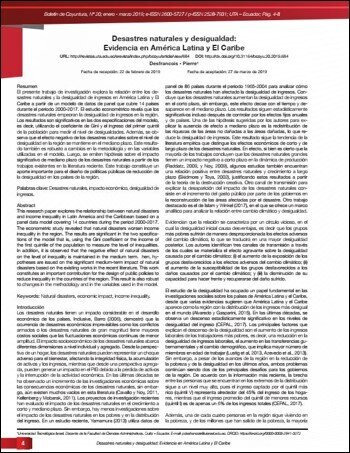Natural disasters and inequality: evidence in Latin America and the Caribbean
Main Article Content
Abstract
This research paper explores the relationship between natural disasters and income inequality in Latin America and the Caribbean based on a panel data model covering 14 countries during the period 2000-2017. The econometric study revealed that natural disasters worsen income inequality in the region. The results are significant in the two specifications of the model that is, using the Gini coefficient or the income of the first quintile of the population to measure the level of inequalities. In addition, it is observed that the negative effect of natural disasters on the level of inequality is maintained in the medium term. hen, hypotheses are issued on the significant medium-term impact of natural disasters based on the existing works in the recent literature. This work constitutes an important contribution for the design of public policies to reduce inequality in the countries of the region. This result is also robust to changes in the methodology and in the variables used in the model.
DOI: https://doi.org/10.31164/bcoyu.20.2019.684
URL: http://revistas.uta.edu.ec/erevista/index.php/bcoyu/article/view/684
Downloads
Article Details

This work is licensed under a Creative Commons Attribution-NonCommercial 4.0 International License.
![]()
The publications of the Boletín de Coyuntura are licensed under a Creative Commons Attribution-NonCommercial 4.0 International License (CC BY-NC 4.0). The Universidad Técnica de Ambato retains the copyright of the published works, and favors and allows the reuse of these, as long as: the authorship and original source of publication is cited, and they are not used for commercial or onerous purposes. The intellectual property of the published articles belongs to the authors.
References
Azevedo, J. P., Inchauste, G., Olivieri, S., Saavedra, J., & Winkler, H. (2013). Is labor income responsible for poverty reduction? A decomposition approach. The World Bank.
Baez, J. E., & Santos, I. V. (2008). On shaky ground: The effects of earthquakes on household income and poverty. RPP LAC-MDGs and Poverty-02/2008, RBLAC-UNDP, New York.
Baez, J. E., Rodriguez-Castelan, C., & Fuchs, A. (2017). ¿Desarrollo Económico Inestable? Choques Agregados en América Latina y el Caribe. The World Bank.
Barro, R. J. (2006). Rare disasters and asset markets in the twentieth century. The Quarterly Journal of Economics, 121(3), 823-866.
Bello, O. (2017). Desastres, crecimiento económico y respuesta fiscal en los países de América Latina y el Caribe, 1972-2010. Revista Cepal.
Berry, A. (1998). Poverty, economic reform & income distribution in Latin America. Boulder, Colorado, Lynne Rienner.
Caruso, G., & Miller, S. (2015). Long run effects and intergenerational transmission of natural disasters: A case study on the 1970 Ancash Earthquake. Journal of development economics, 117, 134-150.
Cavallo, E., & Noy, I. (2011). Natural disasters and the economy—a survey. International Review of Environmental and Resource Economics, 5(1), 63-102.
Charvériat, C. (2000). Natural disasters in Latin America and the Caribbean: An overview of risk. Working paper 434, Inter-American Development Bank, Washington DC.
Comisión Económica para América Latina y el Caribe (CEPAL). Panorama Social de América Latina, 2017 (LC/PUB.2018/1-P). Santiago, 2018
Helmer, M & Hilhorst, D. (2006). Natural disasters and climate change. Disasters, 30(1), 1-4.
Ishizawa, O. A., & Miranda, J. J. (2016). Weathering storms: understanding the impact of natural disasters on the poor in Central America. The World Bank.
Islam, S. N., & Winkel, J. (2017). Climate change and social inequality. United Nations, Department of Economic and Social Affairs.
Kellenberg, D. K., & Mobarak, A. M. (2008). Does rising income increase or decrease damage risk from natural disasters?. Journal of urban economics, 63(3), 788-802.
López-Calva, LF and E Ortiz-Juárez (2009). Evidence and Policy Lessons on the Links between Disaster Risk and Poverty in Latin America: Methodology and Summary of Country Studies. Research for Public Policy, MDGs and Poverty, MDG-01-2009, RBLAC-UNDP, New York.
Lustig, N., Lopez-Calva, L. F., Ortiz-Juarez, E., & Monga, C. (2016). Deconstructing the decline in inequality in Latin America. In Inequality and growth: Patterns and policy (pp. 212-247). Palgrave Macmillan, London.
Mendelsohn, R., & Williams, L. (2004). Comparing forecasts of the global impacts of climate change. Mitigation and Adaptation Strategies for Global Change, 9(4), 315-333.
Morley, S. A. (2000). The effects of growth and economic reform on income distribution in Latin America. Cepal Review.
Morris, S. S., Neidecker-Gonzales, O., Carletto, C., Mungu??a, M., Medina, J. M., & Wodon, Q. (2002). Hurricane Mitch and the livelihoods of the rural poor in Honduras. World development, 30(1), 49-60.
Mueller, V. A., & Osgood, D. E. (2009). Long-term impacts of droughts on labour markets in developing countries: evidence from Brazil. The Journal of Development Studies, 45(10), 1651-1662.
Noy, I. (2009). The macroeconomic consequences of disasters. Journal of Development economics, 88(2), 221-231.
Raddatz, C. (2009). The wrath of God: macroeconomic costs of natural disasters. The World Bank.
Skidmore, M., & Toya, H. (2002). Do natural disasters promote long?run growth?. Economic inquiry, 40(4), 664-687.
Székely, M., & Mendoza, P. (2015). Is the decline in inequality in Latin America here to stay?. Journal of Human Development and Capabilities, 16(3), 397-419.
Vakis, R. N. (2006). Complementing natural disasters management: the role of social protection. World Bank, Social Protection.
Yamamura, E. (2013). Impact of natural disasters on income inequality: Analysis using panel data during the period 1965 to 2004. Munich Personal RePEc Archive.


